




Welcome to our blog. We'll be using this blog to update friends and relatives about life in Lafayette, Indiana, USA.
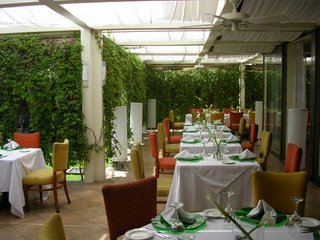 time, we showed up about an hour earlier than the restaurant opened. As Tyler and I were standing on the sidewalk, disappointed, trying to decide what to do next, a woman came up from behind asking in English if we needed help. Before turning around,
time, we showed up about an hour earlier than the restaurant opened. As Tyler and I were standing on the sidewalk, disappointed, trying to decide what to do next, a woman came up from behind asking in English if we needed help. Before turning around,  earlier for us.” As we both turned around, we saw the woman who had addressed us standing in her chef’s jacket and Dansko clogs. Just the shoes alone told us she was a woman to be reckoned with. As it turned out, Titi, our chef, invited us in and sat us down at the bar of the restaurant. As the restaurant had not opened for the day yet, we were the only patrons there. But that didn’t stop Titi. Three different times she left her kitchen to personally deliver to us three incredible appetizers: Vietnamese spring rolls, crab wontons with a ginger and plum reduction sauce, and avocad
earlier for us.” As we both turned around, we saw the woman who had addressed us standing in her chef’s jacket and Dansko clogs. Just the shoes alone told us she was a woman to be reckoned with. As it turned out, Titi, our chef, invited us in and sat us down at the bar of the restaurant. As the restaurant had not opened for the day yet, we were the only patrons there. But that didn’t stop Titi. Three different times she left her kitchen to personally deliver to us three incredible appetizers: Vietnamese spring rolls, crab wontons with a ginger and plum reduction sauce, and avocad o and mole egg rolls (see photo left). We were definitely staying for lunch. Tyler and I both ordered tuna, mine peppered, his with Titi’s own barbecue sauce. Based on the food, we of course had to order dessert – a chocolate and raspberry mousse (see photo right). The food we had at Tamarindos was some of the best food we’ve ever had, anywhere. Best yet, Titi has family in Xela, where we will be living, and promised to come over to our place for dinner when in town. Also, she said if we wanted, she could arrange to have fresh fish delivered to us in Xela. Therefore, as you can gather, Titi is the most important person we have met in
o and mole egg rolls (see photo left). We were definitely staying for lunch. Tyler and I both ordered tuna, mine peppered, his with Titi’s own barbecue sauce. Based on the food, we of course had to order dessert – a chocolate and raspberry mousse (see photo right). The food we had at Tamarindos was some of the best food we’ve ever had, anywhere. Best yet, Titi has family in Xela, where we will be living, and promised to come over to our place for dinner when in town. Also, she said if we wanted, she could arrange to have fresh fish delivered to us in Xela. Therefore, as you can gather, Titi is the most important person we have met in
When we weren’t sampling the food,
Quetzaltenango (Xela), September 7-
Xela looks like many Latin American cities in that its downtown is a grid of single-wide, one-way streets with “Avenidas” running north and south and “Calles” running east and west. Some of the streets are still paved with cobblestones, which, in addition to their narrow width, is a reminder that the streets were not originally made for cars. On many streets, cyclists and pedestrians alike must press themselves up against the wall to avoid having their toes run over. Or, if crossing the street, you are sure to be honked at if you are not moving out of the way quick enough. But that’s life downtown. In this photo I took of
not moving out of the way quick enough. But that’s life downtown. In this photo I took of
Beginning with our stay in the “Baby Adoption Hotel”, our lives cont inue to be filled with ironies. My mom got a big kick out of hearing that Tyler and I are now living in the suburbs of Xela, in a gated community. We have now lost any footing to tease her about her lifestyle choice. And, the closest restaurants to our house include Burger King and McDonald’s. This photo is a shot of the street that runs in front of our gated community. The following photo (below, right) shows a picture of
inue to be filled with ironies. My mom got a big kick out of hearing that Tyler and I are now living in the suburbs of Xela, in a gated community. We have now lost any footing to tease her about her lifestyle choice. And, the closest restaurants to our house include Burger King and McDonald’s. This photo is a shot of the street that runs in front of our gated community. The following photo (below, right) shows a picture of  s where you’ll find our house sandwiched between, Don Jaime’s house, the architect who built all the houses in the complex, on the left, and his office to the right. Further down the main road is all the other houses in the complex. Therefore, even within the compound, we are somewhat segregated from our neighbors – affluent Guatemalans. Below is a photo tour of our new home away from home and the surrounding grounds.
s where you’ll find our house sandwiched between, Don Jaime’s house, the architect who built all the houses in the complex, on the left, and his office to the right. Further down the main road is all the other houses in the complex. Therefore, even within the compound, we are somewhat segregated from our neighbors – affluent Guatemalans. Below is a photo tour of our new home away from home and the surrounding grounds.

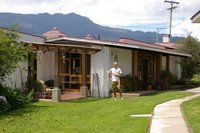

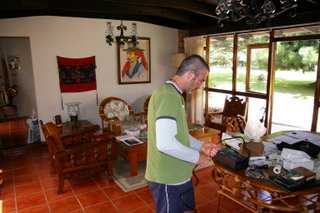 room/dining room.
room/dining room. 



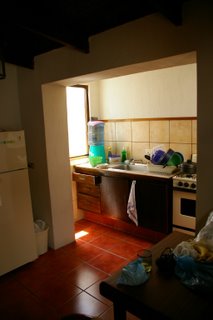 eakfast nook:
eakfast nook:
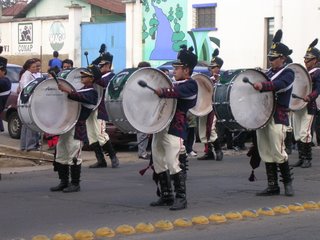 kend in Xela,
kend in Xela,  n). The week culminates in the crowning of Queen
n). The week culminates in the crowning of Queen Tyler and I decided to take advantage of m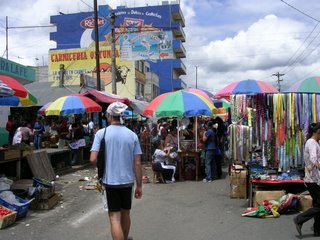 ost people being at the fairgrounds to do a little grocery shopping at the “Mercado La Democracia”, the largest open air market downtown. Try to spot the meat department, the fish market, the spice aisle and the produce section in the photos below.
ost people being at the fairgrounds to do a little grocery shopping at the “Mercado La Democracia”, the largest open air market downtown. Try to spot the meat department, the fish market, the spice aisle and the produce section in the photos below.


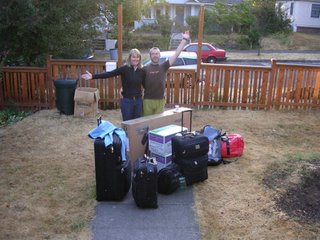 As always, we enjoyed the past several days hanging out with our guide to local food in Portland, Eve. We put our stuff into a storage unit, ate lots of food, packed our luggage for Guat, and ate lots of food. We made sure to have plenty of Mexican, Thai, Indian, Italian, and,of course, locally grown organic at one of Portland’s finest restaurants, The Farm, knowing that the form these foods come in may be completely different in Guatemala or simply unavailable. (Yes, Guatemalan food is quite different from Mexican.) Thursday, August 31 We left the US with A TON of luggage (see photo). We checked a total of 6 items, one of which was oversized, 3 of which were overweight. (Kind of like how we were feeling after grazing through Portland’s eateries.) Tyler’s bike box was just 1 pound short of having to pay an additional $100 – SHAZAAAM! High 5! Thanks to Eve’s neighbor Susie for lending us the bathroom scale. We ended up paying $400 bucks to ship all the extra luggage, but we expected it. You either buy new stuff, or schlep your old stuff to the new place. And, the cost of shipping personal items was covered in Cris’ stipend. ☺
As always, we enjoyed the past several days hanging out with our guide to local food in Portland, Eve. We put our stuff into a storage unit, ate lots of food, packed our luggage for Guat, and ate lots of food. We made sure to have plenty of Mexican, Thai, Indian, Italian, and,of course, locally grown organic at one of Portland’s finest restaurants, The Farm, knowing that the form these foods come in may be completely different in Guatemala or simply unavailable. (Yes, Guatemalan food is quite different from Mexican.) Thursday, August 31 We left the US with A TON of luggage (see photo). We checked a total of 6 items, one of which was oversized, 3 of which were overweight. (Kind of like how we were feeling after grazing through Portland’s eateries.) Tyler’s bike box was just 1 pound short of having to pay an additional $100 – SHAZAAAM! High 5! Thanks to Eve’s neighbor Susie for lending us the bathroom scale. We ended up paying $400 bucks to ship all the extra luggage, but we expected it. You either buy new stuff, or schlep your old stuff to the new place. And, the cost of shipping personal items was covered in Cris’ stipend. ☺ I meandered through the city to do some bicycle recon. I would have gone directly to my destination, but despite having a map, I got lost several times, causing the meandering. The city seems fairly normal: For example, there’s a big-city bustle, there’s a major pollution problem, drivers are aggressive toward non-motorized traffic. The architecture and behavior of drivers is familiar if you’ve visited Latin America. What surprised me was the amount of heavily armed guards, not those in front of banks but standing in the parking lot of Wendy’s with a giant shotgun or guarding a typical-looking office building with heavy firepower, for example. For a look at the typical type of shotgun you’d see in the streets here, take a look at this photo I pirated from someone else’s site.
I meandered through the city to do some bicycle recon. I would have gone directly to my destination, but despite having a map, I got lost several times, causing the meandering. The city seems fairly normal: For example, there’s a big-city bustle, there’s a major pollution problem, drivers are aggressive toward non-motorized traffic. The architecture and behavior of drivers is familiar if you’ve visited Latin America. What surprised me was the amount of heavily armed guards, not those in front of banks but standing in the parking lot of Wendy’s with a giant shotgun or guarding a typical-looking office building with heavy firepower, for example. For a look at the typical type of shotgun you’d see in the streets here, take a look at this photo I pirated from someone else’s site. the most common tree plantings here along city streets between the sidewalk and street is a giant ficus. If you don’t have a ficus benjamina in your house, then you certainly saw one on your last trip to the dentist’s office (see photo right). But imagine this same tree 20-40 feet high. I also saw a schefflera arboricola (see photo left)
the most common tree plantings here along city streets between the sidewalk and street is a giant ficus. If you don’t have a ficus benjamina in your house, then you certainly saw one on your last trip to the dentist’s office (see photo right). But imagine this same tree 20-40 feet high. I also saw a schefflera arboricola (see photo left)  which I’ve only seen previously in pots, and here they grow with trunks 2 – 3 feet in diameter with root systems 10 – 15 feet wide that rip up the sidewalks and streets. AWESOME! (Stories of street crime have prevented us thus far from taking our cameras out onto the streets to take our own pictures. We’ll be much more at ease once reaching our town of Xela.)
which I’ve only seen previously in pots, and here they grow with trunks 2 – 3 feet in diameter with root systems 10 – 15 feet wide that rip up the sidewalks and streets. AWESOME! (Stories of street crime have prevented us thus far from taking our cameras out onto the streets to take our own pictures. We’ll be much more at ease once reaching our town of Xela.)